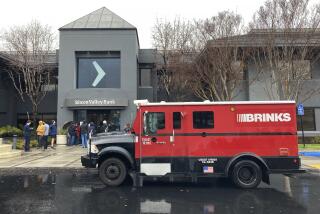OCTA Votes to Continue Light-Rail Study : Transportation: Supervisor Silva’s move to divert funds toward county bankruptcy recovery, backed by several members of the public, is rejected 9 to 2.
Despite opposition from two of its directors and several members of the public, the Orange County Transportation Authority board voted Monday to continue a $3-million study of an urban light-rail system and bus and freeway improvements.
Jim Silva, one of four Orange County supervisors who double as OCTA directors, made an unsuccessful try to persuade his colleagues to call off the study and use the $340 million of Measure M money set aside for light-rail development to help solve the county’s bankruptcy.
“We have to look for solutions to the crisis. The pieces of the puzzle are right here,” Silva said. “I’m not saying we’ll never have a rail system in the county, but this [financial crisis] is our first obligation--just like a family has an obligation to put food on the table before building a new driveway.”
Like the county’s financial and legal consultants, as well as its legislative delegation in Sacramento, Silva has proposed taking some of OCTA’s money to help repay the county’s debts.
But Monday, he won support only from Supervisor Roger R. Stanton as the board voted 9 to 2 to continue the study.
“I’ve got my OCTA hat on. I’m not here to solve the county’s bankruptcy problem,” said director Thomas W. Wilson, a member of the Laguna Niguel City Council. “There’s a true need to look at tomorrow’s transportation needs today. Planning for our future, in terms of trying to get from point A to point B, is mandatory.”
After contacting about 25,000 people through surveys and public forums, the OCTA staff has identified six prospects for its “major investment study,” which is intended to provide comprehensive technical data about bus, freeway and light-rail alternatives by January.
Only two of the options include an urban light-rail system. The other four are: not building anything new; improving the transportation system by increasing bus service by 30% and upgrading streets; doubling bus service; focusing on freeway and road improvements.
Although a board majority backed intensive study of the six options, several members of the public criticized OCTA for even considering light rail, and agreed with Silva that the money would be better spent to help solve the county’s financial problems.
“While your planners are talking about balanced, multimodal systems, the rest of us are just trying to find a way to go to work,” said Bill Mello of the citizen group Drivers for Highway Safety.
“We need to kill the whole thing. The county’s bankrupt!” said Wayne King. “What we need is to just fix our roadways. If you leave us alone, we’ll get to work on roads in our own cars.”
Also on Monday, the OCTA board approved a shift of some $50 million among its various accounts to cover short-term cash needs while awaiting payment of $221 million the agency is owed by the county because of losses incurred last fall, when falling interest rates triggered the collapse of the county-run investment pool.
Under a court-approved settlement agreement, OCTA--like the 200 other government agencies that had money in the pool--got back 77% of its pre-bankruptcy pool deposits in May, and another 3% in June. The county still owes the agency about $101 million in senior claims, which are to be repaid from proceeds of the county’s litigation against Wall Street firms, and another $120 million in “repayment claims.” The county has promised to make its “best efforts” to pay these, but has not outlined a timetable or means of payment.
To cover for the losses while awaiting repayment of the claims, OCTA will move money from an endowment fund for the urban light-rail program into several other accounts, including those that fund bus operations, freeway call boxes and commuter rail projects from Los Angeles to San Diego and Riverside to Irvine.
“The funding plan will ensure essential transit operations and immediate construction and acquisition obligations,” said OCTA Director of Planning and Development Dave Elbaum. “The strategy [ties] the bankruptcy claims to long-range efforts. Hopefully, those claims will be repaid before the funds are needed.”
However, the investment losses could still impact OCTA projects--delaying construction projects on the Riverside and Costa Mesa freeways and commuter-rail improvements from Santa Ana to Orange--if the bankruptcy-related claims are not repaid in a timely manner.
More to Read
Start your day right
Sign up for Essential California for news, features and recommendations from the L.A. Times and beyond in your inbox six days a week.
You may occasionally receive promotional content from the Los Angeles Times.






